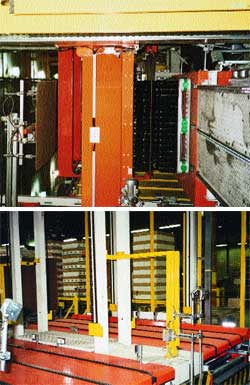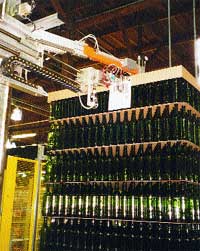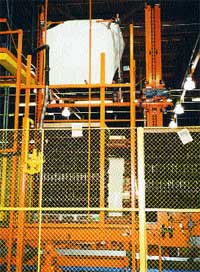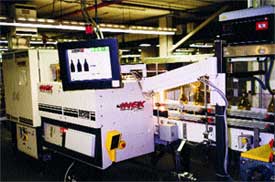April 2, 2015

Founded in 1933, E&J Gallo Winery is the largest producer of wine in the world, with annual sales exceeding $1.4 billion. Its Livingston, Fresno, and Modesto, CA, plants are among the largest wineries in the world. With this scale of operations, the company has committed to beginning-to-end integration, starting with bottle making at the front end, and ending with its own trucking and distribution operations.
Exemplifying this commitment, Gallo Glass Company's Modesto plant has four glass-making furnaces feeding 14 bottle manufacturing lines that make more than 60 different bottles. The bottles had traditionally been packed in cases for delivery to the packaging line, but in '98, the plant implemented an ambitious project with Emmeti USA to convert to bulk palletizing of the bottles. During the first phase of this transition, Gallo installed three palletizers, a pallet shuttle car, a pallet dressing line and a reselect/rework line incorporating a palletizer and depalletizer. As part of the changeover from cased to bulk bottles, the Modesto filling plant also installed bottle depalletizers on two of its packing lines.
All Emmeti equipment supplied to Gallo Glass is designed according to the European Economic Communities Directive on Machine Safety (89/332), which is stricter than OSHA's machine safety directives. Gallo was visited by California's OSHA after the installation of Emmeti's equipment, and OSHA found no problems or violations of any nature with Emmeti's equipment. (Cal OSHA can enter a plant unannounced, whereas USA OSHA must have a request or reason to enter a facility.) While not required by Gallo, Emmeti has supplied equipment with the UL seal of approval to other customers.
"We learned about Emmeti from our contacts in the glass industry and visited a number of their customers in Europe to learn more about them firsthand," says operations support manager Mike Pyeatt. "We found that they were very familiar with the unique challenges of the glass industry and had experience handling difficult-shaped bottles, and their equipment can be changed for different sizes and shapes very quickly."
Although the equipment is built in Europe, all equipment is supplied with non-proprietary components, such as Allen-Bradley programmable logic controllers (PLCs), that can be sourced from local suppliers. Emmeti USA has a stock of spare parts and USA-based technical personnel to complement the service and support available from Italy.
The Emmeti equipment begins with two Sipac (Emmeti's sister company) conveying systems transporting bottles from the ends of the annealing lehrs to the palletizers. Bottles are inspected by equipment from Inex Vision Systems (see the accompanying sidebar on p. 87) and Emhart Glass as they are being conveyed. The Sipac equipment includes tabletop conveyors, accumulation tables, cullet conveyors, and Omega Elevator/Lowerator Systems. PLCs and customized software allow the bottles to be conveyed with limited human intervention from the end of the lehr to the palletizer.
The Omega System includes elevators that raise the bottles approximately eight feet overhead, where they are transported by side grippers for approximately eight feet before they are lowered to the palletizing equipment. Bottles are gripped by rubber pads, which are fixed in place with a double plastic chain that is specially coated for ultimate durability. The chains are adjustable using a threaded rod that is cranked by a handwheel to accommodate different bottle sizes and shapes. The system allows passage for both plant personnel and forklifts to run underneath the conveyor as the bottles move across overhead.
During their descent in the Omega System, bottles are turned upside-down, and blasts of filtered air are blown into the bottles to ensure they are not contaminated with dust particles or other foreign objects, before being turned upright for transfer to the palletizing area.
Pick up bottles with rubber gripping tubes
Gallo has installed three Emmeti MT 554 automatic bulk palletizers for empty bottles. One of these is a standalone unit with a dedicated top tray former/inserter and discharge conveyor, while the other two share a common top tray former/inserter and discharge conveyor. The Model MT 554 is a floor-level palletizer capable of handling a wide range of bottle shapes and sizes. The MT 554 can handle round and nonround containers, including reverse-tapered bottles, oval- and kidney-shaped flasks, and jugs with handles, as well as square and rectangular containers. During PD's visit, the standalone line was running 1.5-L straight-sided round bottles at 250 bottles/min. Bottles are stacked six layers high, with 125 bottles/layer. The palletizers run 100 to 130 pallets in a typical 24-hour day.
"The palletizers can be operated in two different modes–pick-and-place and sweep–which we like because of all of the different bottles we run," says Pyeatt. "The pick-and-place mode uses inflatable rubber gripping tubes to pick up the bottles. These provide very positive, yet gentle handling." Bottles are delivered to the palletizers by Emmeti MT 518/4 four-lane bottle-feeding systems. These are "intelligent" systems that can produce the desired layer pattern even if one, two, or even three bottle infeed lanes are not operating due to jams on the line, low line speed, etc.
Bottles entering the palletizer are counted and recounted, to ensure that the correct number of bottles enter on each infeed lane. If the counts do not match the information stored in the system's memory, an alarm is triggered to alert plant personnel, and bottle flow for the lane with the error is halted until the problem is rectified. The system will automatically alter its operation to continue to make the correct layer pattern.
The bulk palletizing machines at Gallo Glass are equipped with four-row stackers. Emmeti produces systems with one-, two-, three-, four-, six- and eight-row container infeed systems. The number of infeed rows depends on the speed of the palletizer. The capacity of the four-row stackers, like the unit at Gallo, is approximately 40 rows/min, depending on the height and stability of the containers.
|
A layer pad (tier sheet or slipsheet) is automatically placed between each layer of bottles, top. A four-pallet shuttle car, bottom, transports product and pallets between palletizers and downstream equipment. |
After the rows of bottles enter into the stacker, they are moved forward onto the layer accumulation table, which is equipped with integral layer separators to stop the travel of bottles until an entire layer is formed. Once the layer is complete, the separator is raised, and the layer travels forward to wait for transfer onto the pallet.
When round containers are being palletized, the layer accumulation table runs continuously, since these bottles are very stable and are not prone to falling over.
When running nonround containers, Emmeti provides a motor controlled by an encoder to control the movement of the table. This enables the table to run in a pitch-by-pitch (noncontinuous) mode according to the bottle's diameter. This method of controlling the accumulation table reduces the potential for bottles to fall during layer formation, especially for some of the more challenging bottles that Gallo produces.
Fast conversion for different bottle sizes
A unique feature of the MT 554, and one of the keys to the system's versatility, is its ability to operate as a sweep-type palletizer, or to be quickly converted to a pick-and-place-type system for bottles that are not easily transferred from the layer formation table to the pallet via the sweep method, such as reverse-tapered bottles. The systems at Gallo are designed to operate at speeds up to three layers/min when using the sweep-type method of bulk palletizing, or four layers/min with the pick-and-place head. The machines were running the pick-and-place head during PD's visit.
The pick-and-place head utilizes rubber gripping tubes that are inflated to capture the layer during the transfer from the accumulation table to the pallet, and are deflated when the bottles are properly positioned on the pallet. The pick-and-place head's gripping tubes are designed according to each bottle's specifications, so that a variety of heads are needed for the entire range of bottles produced by Gallo Glass. The major advantage of using the system in sweep mode is that no parts are required for a job change.
A standard job change requires recalling a stored recipe file from the system's PLC via the control console. The MT 554 operating in sweep mode can be job-changed in about 15 min, while a unit utilizing the gripping tubes will require approximately 30 min. Another advantage of the MT 554 is that it guarantees no voids in the layer of bottles. This ensures load stability, while also maximizing the number of bottles on a pallet, thus reducing shipping costs. The reason that there are no voids in layer formation is due to the Model MT 518 "intelligent" bottle feeder described previously.
Another key component integrated into the bulk palletizing systems at Gallo Glass is the layer formation system. Gallo opted to use inverted fiberboard trays in place of top frames at the top of each palletload of bottles. This was done to accommodate the shrink wrapper (Gallo does not stretch-wrap the bulk pallets). The Emmeti Model MT 420 automatic tray-forming machines are furnished with stacks of prescored and cut fiberboard on a pallet. The tray former folds and glues the tray prior to its placement onto the top of the palletload of bottles. The output capacity of the tray-forming machine is 4 trays/min.
The palletizer also has an integral layer pad (tier sheet or slipsheet) inserter and a pallet unstacker. Each of these items, including the empty pallet, the layer pad, the layer of bottles, and the inverted tray, are centered automatically by the system to ensure stability of the load.
Up to four palletloads of bottles can be accumulated on the palletizer's discharge conveyor. These are monitored by electric eyes, and the palletizer shuts down when four pallets are present.
The palletizers have two conveyors, one above the other, at all of the infeed and outfeed points. Empty pallets are delivered from the shuttle to the palletizer on the bottom infeed conveyor. The pallet is then hoisted into the loading level. Once the palletload is built, it exits the palletizer on the top conveyor level. The dunnage coming to the palletizer is handled in the opposite manner. Full loads are delivered to the top conveyor, and when the dunnage pallet is empty, it is lowered via a hoist and travels on the bottom conveyor to the shuttle car.
Shuttle car handles pallets automatically
To minimize human intervention on the bulk palletizers, including eliminating service by forklift operators, Gallo decided to install Emmeti's Model MT 558/4 four-pallet shuttle (also called transfer or "T") car. Emmeti produces one-, two-, four- and six-pallet shuttle cars. The number of dropoff and pickup points that must be serviced by the car, as well as the distance between the points, determines the number of pallets that the car is designed to accommodate.
The shuttle car has a presser pad for each of the four stations on the car to secure the load during travel through the plant.
Gallo is using a unique shuttle car that incorporates two conveyor beds, one atop the other, in place of the usual single conveyor-bed car. This two-level design was provided to eliminate the need for any forklift interaction with the palletizers. The top conveyor carries completed, unstrapped loads of glass from the palletizers to the final packaging line for shrink wrapping, or to Gallo's reselect line. The top conveyor is also used or to carry stacks of layer pads and stacks of tray blanks from the staging conveyor to the bulk palletizers. The bottom conveyor of the shuttle car is used to transport empty pallets from a staging conveyor to the palletizers. The different levels have bi-directional conveying capabilities so that the system can pick up or deliver to either side of the car.
|
The system prints alphanumeric and bar-code information on labels with a laser, and then applies them to pallets of bottles. |
The entire shuttle-car pickup and delivery operation is controlled by Emmeti software. The shuttle car receives pickup and delivery communications from the palletizers and acts in the manner that will maximize material flow.
One shuttle car performs the function of several fork drivers, thus adding to the level of automation in the factory. The system includes safety barriers and audible alarms to protect plant personnel. It travels on rails in the floor that can be passed over by other forklifts performing their duties in other parts of the factory.
Totally enclosed pallets
Finished loads are stored either in Gallo's warehouse or stacked outside in an open-air environment. One of the key concerns at Gallo Glass is complying with the Food and Drug Administration's Good Food Manufacturing Practices, and all equipment at Gallo is designed to comply with these guidelines. In order to reduce the risk of bugs, snakes, dirt, debris or any other foreign matter entering into the pallet during storage, Gallo adopted a two-stage process to completely enclose every palletload of bottles.
This starts in the pallet-dressing operation, where a sheet of plastic is placed on each empty pallet before it is delivered to the palletizer. In this operation, a stack of 15 empty pallets enters the system.
The entire stack, excluding the one on the bottom, is lifted so that the one pallet that was not lifted can move forward into the system's centering device. Plastic is pulled from a roll until it covers an area exceeding the dimensions of the pallet. The plastic is then automatically cut to the correct size, and four hot-air guns located at the corners of the pallet shrink the plastic so that it adheres to the pallet. Pallets are then sent to the staging conveyor for pickup by the shuttle car.
The second stage of the process concerns the finished palletloads of bottles. Each pallet is delivered to a shrink-wrapping operation from MSK Covertech, Inc., where a plastic bag is pulled over the bulk load, after which the shrink film is secured to the plastic on the pallet as part of the heat-shrinking process. Thus the bottles are sealed from the environment.
The equipment installed in the glass plant consists of an MSK Paratech hood applicator, an MSK shrink ring, and MSK conveyors. The pallets with bulk glass are transported onto the first MSK conveyor, where the pallet stops, is centered on the conveyor and is recognized for pallet size. This information is then tracked throughout the packaging line.
After centering, the pallet moves to the bagging station, where the MSK Paratech creates a bag from a roll of gusseted tubing. The machine measures the height of the load and automatically adjusts the length of the bag accordingly. Depending on the pallet dimensions, the machine automatically selects from two different bag sizes (up to six different sizes are possible). Using the parachute principle, the MSK Paratech pulls the bag over the bulk glass. This keeps the bag from touching the corners of the product, so no bottles will fall off the pallet.
The pallet then moves to the shrink station. The MSK shrink ring is a gas-heated machine that only uses energy when it is actually wrapping a product. Gallo uses the "glass shrink" program option, shrinking the bag from the top down, so that air trapped inside the bag escapes before the bag is sealed to the pallet dressing.
During this initial operation, the pallet is lifted with a hydraulic scissors lift, while the shrink ring moves down to the bottom of the pallet. The film is heated at pallet level during this "under-shrink" step, while a vacuum is pulled to ensure the plastic shrinks underneath the pallet. Next, the shrink ring moves up to the top of the pallet, and then travels back down the pallet to heat-shrink the film around the bottles. When the ring reaches reaches the bottom of the pallet, it starts its dwell time for the bottom shrink that seals the shrink film to the pallet dressing.
With the bag heat-sealed to the pallet-dressing that was placed on the pallet previously, a six-sided enclosed package is created. The scissors lift lowers the pallet, and the film is clamped between the pallet and the conveyor where it cools down.
|
A hood applicator creates a bag from a roll of tubing and then pulls it over the palletload of bottles. |
Finally, the ring moves to its home position, and the wrapped product moves on to the next conveyor, where it is picked up by forklifts. The equipment at Gallo runs at approximately 60 pallets/hr.
To identify each pallet of product, Gallo has installed Emmeti's Model MT 440 pallet label printing and application system. This automatically prints and applies a label, or multiple labels, on the rim of a top tray, directly on containers, on the outside of a wrapped pallet, or elsewhere according to the customer's needs.
The system utilizes a Hewlett-Packard laser printer to print labels containing alphanumeric and bar-code information. The operator can program the system to print the desired information, such as the shop from which the load came, time and date, lot code, number of bottles per load, etc. Once the label is printed, quick-drying permanent glue is applied, and a mechanical arm with vacuum-actuated suction cups picks and applies it.
Line reinspects, cases bottles
Gallo has a separate line, called the Reselect Line, designed to reinspect bottles for quality control purposes, and also pack bottles previously warehoused as bulk into cases. The line incorporates a Model MT 565 bulk depalletizer, which is the same system used on the packaging lines at Gallo Winery. This is essentially the same as the MT 554 bulk palletizer, without the layer formation system, and it operates in reverse. The palletizer has the ability to sweep bottles off of the pallet onto the takeaway table, or it can be converted to a pick-and-place system for more-demanding bottle shapes. Bottles that are to be packed into cases are sent to an automatic case packer. Bottles that pass all of the reinspection tests, and are not going to the case packer, are sent to a Model MT 554 bulk palletizer. The only difference between this unit and the ones on the production lines is that this unit has only one infeed lane, since speed requirements are much slower than on the bottle production lines.
The Emmeti equipment at Gallo uses Allen-Bradley programmable logic controllers and personal computers with touchscreens. It includes a human-machine interface (HMI) with extensive use of graphic language designed for plant personnel with limited computer skills.
"The Emmeti equipment has been very reliable, and their service has been excellent. Their remote troubleshooting capability has been a real benefit. Emmeti service technicians can look at our PLCs over phone lines and correct problems immediately," says Pyeatt. "Emmeti will certainly be the first company we call when we're ready for our next upgrade or expansion."
More information is available:
Palletizers, depalletizers, pallet shuttle car, pallet dressing line, conveyors, pallet labeling and printing system: Emmeti USA, 814/466-2781. Circle No. 241.
Conveying systems, accumulation tables, cullet conveyors: Sipac .s.r.l, O11-390521-611801. Circle No. 242.
Bottle inspection systems: Inex Vision Systems, 727/535-5502. Circle No. 240.
Bottle inspection systems: Emhart Glass SA, 860/814-4010. Circle No. 243.
PLCs, personal computers, touch screens: Allen-Bradley, 414/382-2000. Circle No. 244.
Hood applicator, shrink ring, conveyors: MSK Covertech, Inc., 770-928-1099. Circle No. 245.
Label printer: Hewlett-Packard, 650/857-1501. Circle No. 246.
Vision systems inspect bottles |
As part of its bottlemaking operation, Gallo Glass has installed a number of inspection systems from Inex Vision Systems. These include five SuperScan 3 base and finish inspection systems, six SuperInspector 2 sidewall and dimensional inspection systems, and three Prolaser dimensional gauging systems. |
You May Also Like






